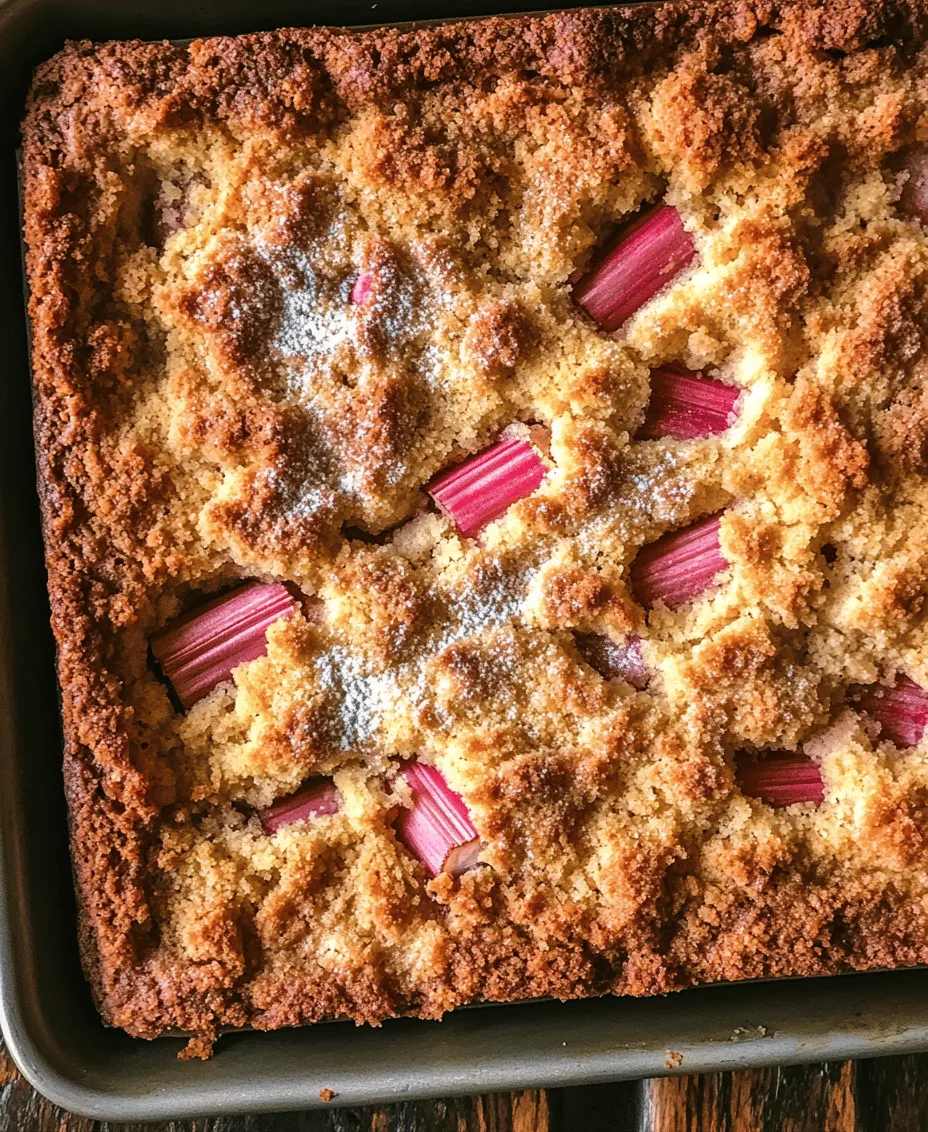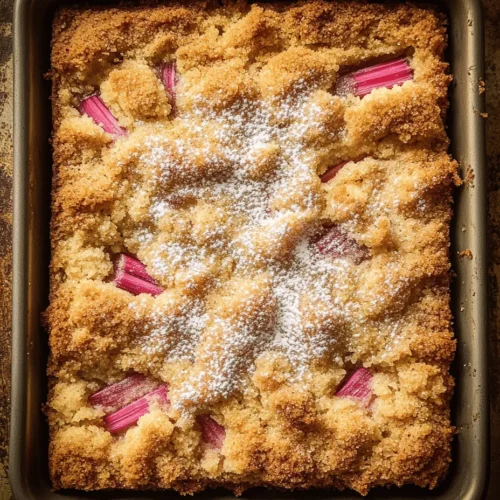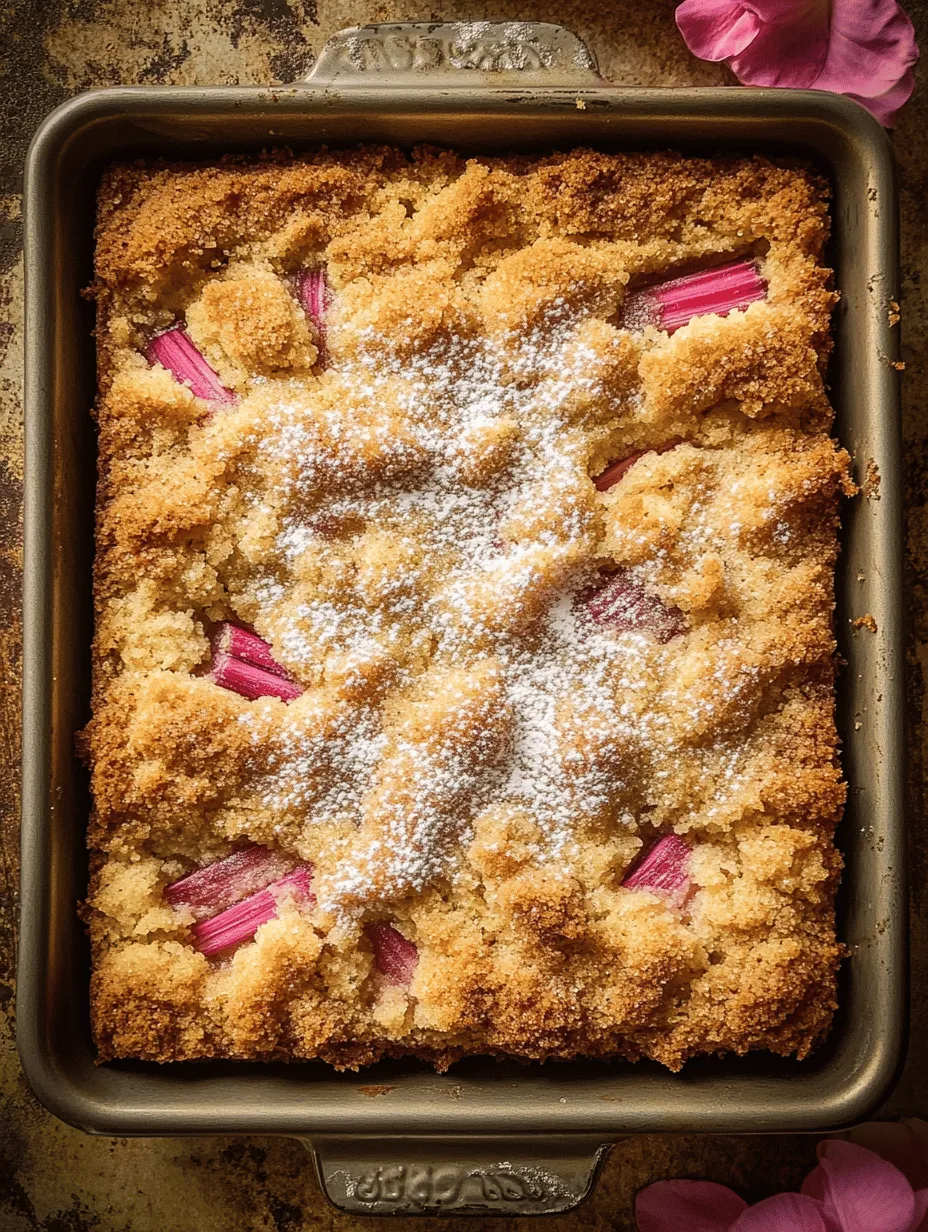Introduction
Coffee cakes hold a special place in the hearts of many, offering not just a delightful treat, but also a cozy connection to mornings spent with loved ones over steaming cups of coffee or tea. Their versatility is unrivaled—whether you’re pairing them with a sweet beverage during brunch or enjoying a slice with your afternoon pick-me-up, coffee cakes can seamlessly adapt to any occasion. They can feature fruits, nuts, and a variety of spices, making them a go-to recipe for those looking to impress guests or indulge in a personal comfort food.
Among the myriad of ingredients that can be incorporated into a coffee cake, rhubarb stands out as a unique and tangy addition. Often mistaken for a fruit due to its culinary uses, rhubarb is actually a vegetable with a bold, tart flavor that balances beautifully with sweet components in baking. Its vibrant pinkish-red stalks not only lend a delightful color to your cake but also a refreshing zing that elevates the overall flavor profile. When combined with a rich batter, rhubarb creates a symphony of tastes that delights the senses.
Another key player in our Rhubarb Sour Cream Coffee Cake is sour cream itself. This ingredient is renowned for its ability to impart moisture and richness to baked goods, resulting in a tender crumb that keeps the cake from drying out. The slight tanginess of sour cream complements the sweet and tart notes of rhubarb, creating a harmonious blend that makes each bite a delightful experience.
In this article, we aim to provide a comprehensive guide to crafting the perfect Rhubarb Sour Cream Coffee Cake. From understanding the significance of each ingredient to detailed preparation steps, we will walk you through the entire process, ensuring that you can create a cake that is not only delicious but also visually appealing.
Understanding the Ingredients
To truly appreciate the beauty of Rhubarb Sour Cream Coffee Cake, it’s essential to understand the role each ingredient plays in the final product. Below, we delve into the components that make this cake a standout.
All-Purpose Flour
All-purpose flour serves as the foundation of our coffee cake, providing the necessary structure to hold the cake together. Its moderate protein content allows for gluten development, which is crucial for achieving a light and fluffy texture. When measuring flour, it’s important to use the spoon-and-level method to avoid packing too much into your measuring cup, which can lead to a dense cake.
Baking Powder and Baking Soda
These two leavening agents are vital for achieving the right texture in our cake. Baking powder is a double-acting leavening agent, which means it releases carbon dioxide gas twice—once when mixed with wet ingredients and again when exposed to heat during baking. Baking soda, on the other hand, requires an acid to activate its leavening properties, helping the cake rise and achieve a light, airy quality. In our recipe, the combination of both ensures that our coffee cake rises beautifully and has a tender crumb.
Salt
At first glance, salt might seem like a simple addition, but it plays a crucial role in enhancing the overall flavor of baked goods. Just a pinch of salt can elevate the sweetness and complexity of the cake, balancing the flavors and ensuring that each bite is satisfying.
Unsalted Butter
The use of unsalted butter is preferred in baking, as it allows you to control the amount of salt in your recipe better. Softened butter is key for creaming, which incorporates air into the mixture and results in a lighter texture. When creamed with sugar, the butter creates tiny air pockets that expand during baking, giving the cake its desired lift.
Granulated Sugar
Granulated sugar is not just the source of sweetness in our cake; it also impacts texture and moisture retention. During the creaming process with butter, sugar helps aerate the mixture, contributing to a light and fluffy structure. Additionally, sugar helps to caramelize the cake’s surface, creating a beautiful golden-brown crust.
Eggs
Eggs serve multiple purposes in our coffee cake. They act as binding agents, holding the ingredients together, and they also contribute to the moisture and richness of the cake. The proteins in eggs help provide structure, while the fat in the yolks adds flavor and tenderness.
Vanilla Extract
A splash of vanilla extract adds depth and warmth to our cake, enhancing the overall flavor profile. It complements the sweetness of the sugar and the tartness of the rhubarb, creating a well-rounded taste that is sure to please your palate.
Sour Cream
Sour cream is a star ingredient in this recipe, contributing both moisture and a subtle tanginess that balances the sweetness of the cake. Its high-fat content ensures that the cake remains tender and rich, preventing it from becoming dry. Using sour cream also enriches the flavor, making every bite feel indulgent.
Rhubarb
Rhubarb is the highlight of our coffee cake, bringing a unique flavor and nutritional benefits. It is low in calories but rich in vitamins K and C, as well as dietary fiber. The tartness of rhubarb contrasts beautifully with the sweetness of the cake, creating a delightful balance. When cooked, rhubarb softens, allowing its flavors to meld with the batter while still providing a slight tang that keeps your taste buds engaged.
Brown Sugar and Cinnamon
The combination of brown sugar and cinnamon adds a delightful topping to our coffee cake, contributing both sweetness and a warm, aromatic flavor. Brown sugar, with its molasses content, offers a deeper, more complex sweetness than granulated sugar, while cinnamon infuses the cake with a comforting warmth, evoking memories of cozy baking days.
Preparation Steps for the Perfect Coffee Cake
Now that we have a thorough understanding of our ingredients, it’s time to dive into the preparation steps that will set you up for success in creating this delicious Rhubarb Sour Cream Coffee Cake.
Preheating the Oven
Before you start mixing your ingredients, it’s crucial to preheat your oven to the correct temperature—typically 350°F (175°C) for coffee cakes. Preheating ensures that your cake begins baking at the right temperature, which is essential for achieving optimal rise and texture. A properly heated oven allows the leavening agents to activate correctly, resulting in a light and fluffy cake.
Greasing and Flouring the Baking Pan
To prevent your coffee cake from sticking, it’s important to prepare your baking pan before adding the batter. Greasing the pan with unsalted butter or cooking spray creates a barrier that helps the cake release easily once baked. After greasing, dust the pan with flour, tapping out the excess. This technique ensures that your cake comes out of the pan smoothly, allowing you to present it beautifully.
Mixing Dry Ingredients
Properly incorporating your dry ingredients lays the foundation for a well-textured cake. Start by measuring your all-purpose flour, baking powder, baking soda, and salt into a mixing bowl. Use a whisk to combine them thoroughly, ensuring that the leavening agents are evenly distributed throughout the flour. This step is crucial for achieving a uniform rise and texture in your coffee cake.
As you prepare to embark on this baking journey, remember that each step taken with care and precision will lead you to a delightful Rhubarb Sour Cream Coffee Cake that is sure to impress. With its irresistible combination of tangy rhubarb and rich sour cream, this coffee cake is the perfect addition to any gathering or an indulgent treat for yourself. Stay tuned for the next part of this article, where we will explore the process of mixing the wet ingredients and assembling the cake for the oven.

Creaming Butter and Sugar
Achieving a light and fluffy texture in your Rhubarb Sour Cream Coffee Cake starts with the creaming of butter and sugar. This step is crucial because it incorporates air into the mixture, which helps leaven the cake as it bakes. Begin by ensuring that your butter is at room temperature; this allows for easier incorporation. Use a stand mixer or a hand mixer on medium speed to beat the butter until it becomes pale and creamy, about 3 to 5 minutes. Gradually add the granulated sugar, continuing to mix until the combination is fluffy and light in color. The key here is patience; take your time to ensure this mixture is well-aerated, as it forms the foundation of your cake’s texture.
Incorporating Eggs
Once your butter and sugar are creamed, it’s time to incorporate the eggs. It’s essential to add the eggs one at a time, mixing well after each addition. This technique ensures that each egg is fully incorporated before adding the next, leading to a more stable batter. If you add the eggs too quickly, the mixture may not emulsify properly, resulting in a dense cake. For best results, beat the eggs in a separate bowl before adding them to the mixture. This way, you can easily check for any shells and ensure a smooth integration into the batter.
Adding Sour Cream
The inclusion of sour cream in your batter not only adds moisture but also contributes to the cake’s rich flavor and tender crumb. When adding sour cream, ensure it’s at room temperature to facilitate better mixing. Gently fold the sour cream into the creamed mixture using a spatula or wooden spoon. This method helps maintain the airy texture you’ve worked to achieve while ensuring that the sour cream is evenly distributed throughout the batter.
Combining Wet and Dry Ingredients
Next, it’s time to combine your wet and dry ingredients. Start by sifting together your dry ingredients—flour, baking powder, baking soda, and salt—in a separate bowl. This process helps to remove any clumps and evenly distribute the leavening agents. Gradually add the dry mixture to the wet mixture, alternating with the remaining sour cream. Begin and end with the dry ingredients, mixing until just combined. Be cautious not to overmix at this stage, as this can develop the gluten in the flour and yield a tougher cake. A few lumps are perfectly fine; they will disappear during baking.
Folding in Rhubarb
Now comes the star of the show—your fresh rhubarb. It’s important to fold in the rhubarb gently to maintain the integrity of the fruit. Cut your rhubarb into small, even pieces to ensure they distribute well throughout the batter. Use a spatula to fold the rhubarb into the batter, turning the mixture over on itself until the fruit is evenly incorporated. Take care not to stir aggressively; this could break down the rhubarb and create a mushy texture.
Baking the Cake
Pouring and Smoothing the Batter
With your batter ready, pour it into a greased and floured 9×13-inch baking pan. Using a spatula, gently smooth the top to create an even surface. This step is important because an even layer will bake more uniformly. Make sure to spread the batter out to the corners and level the top, which will help achieve a beautiful, even rise during baking.
Preparing the Topping
For added flavor and texture, prepare the topping by combining brown sugar and cinnamon in a small bowl. This mixture will create a delightful, caramelized crust on top of the cake as it bakes. Sprinkle the topping evenly over the batter before placing it in the oven. The sugar will melt and form a sweet, crunchy layer that contrasts beautifully with the tender cake beneath.
Baking Time and Temperature
Preheat your oven to 350°F (175°C) and bake the coffee cake for 35 to 40 minutes. To check for doneness, insert a toothpick into the center of the cake; it should come out clean or with just a few moist crumbs attached. The cake should also spring back lightly when touched. Remember, every oven is different, so keep an eye on it during the last few minutes of baking to prevent overbaking.
Cooling the Cake
Once baked, remove the cake from the oven and allow it to cool in the pan for about 10-15 minutes. This cooling time is crucial as it allows the cake to set, making it easier to slice without crumbling. Afterward, transfer the cake to a wire rack to cool completely. This step ensures that the bottom of the cake doesn’t get soggy and maintains its perfect texture.
Serving Suggestions
Presentation Ideas
When it comes to serving your Rhubarb Sour Cream Coffee Cake, presentation can elevate the experience. Consider cutting the cake into squares and arranging them on a beautiful platter. Dust the top with powdered sugar for a touch of elegance. You might also serve individual slices on decorative plates with a sprig of mint for added color and freshness.
Pairing Suggestions
This delightful cake pairs wonderfully with a variety of beverages. A rich cup of coffee complements the flavors of the cake perfectly, enhancing the overall experience. For those who prefer tea, a light herbal or fruit tea can also be a refreshing accompaniment. If you want to make it extra special, serve it with a dollop of whipped cream or a scoop of vanilla ice cream.
Optional Garnishes
For a finishing touch, consider garnishing your slices with a sprinkling of powdered sugar or a light drizzle of icing made from powdered sugar and milk. This not only adds sweetness but also enhances the visual appeal of your coffee cake, making it even more inviting.
Nutritional Information
While indulging in a slice of Rhubarb Sour Cream Coffee Cake, it’s useful to be mindful of the nutritional content. Each serving typically contains approximately 250 calories, with around 10 grams of fat, 35 grams of carbohydrates, and 3 grams of protein. Rhubarb is a low-calorie vegetable packed with antioxidants, vitamins, and minerals, while sour cream adds a creamy texture and flavor. Both ingredients contribute to the overall nutritional profile, but moderation is key to enjoying this treat as part of a balanced diet.
Conclusion
The Rhubarb Sour Cream Coffee Cake is a delightful fusion of flavors and textures that captures the essence of home-baked goodness. With its tender crumb, sweet and tangy rhubarb, and a crunchy brown sugar topping, every bite is a testament to the joy of baking. We encourage you to try this recipe and share it with family and friends, creating lasting memories over a delicious slice of coffee cake. Baking is not just about the end product; it’s about the love and creativity poured into each step. So gather your ingredients, follow these steps, and enjoy the delightful process of making and sharing this scrumptious cake. Happy baking!


